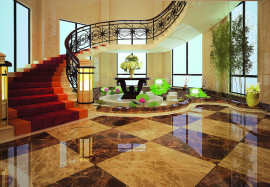The Ten Most common Stone Problems by Frederick M. Hueston
Marble, granite, limestone and other decorative stone are durable materials that will last a life time. However, if not installed correctly or properly cared for, will experience problems that will shorten its life. The following ten problems are the most common in dealing with stone.
1. Loss of shine
The loss of the high polish on certain marble and granite can be attributed to wear. This is especially true of marble, since it is much softer then granite. The bottoms of ones shoe acts like sandpaper on a stone floor surface and over time will wear the polish off. To prevent excessive wear it is important to keep the floor dust mopped, place walk off mats at all entrances. To repair a worn stone surface, it will be necessary to have a professional hone and polish it.>
2. Etching
The dull spot created when liquids containing acids are spilled on marble is called etching. Marble and limestone etch very easily. Granite is more acid-resistance and will rarely etch. To prevent etching, avoid using cleaners and chemicals that contain acids. Bathroom cleaners, toilet bowl cleaners and lemon cleaners commonly contain acids. Certain drinks and foods contain acids and will also etch. Light etching can be removed with a little marble polishing powder. Deep etching will require resurfacing of the stone.
3. Staining
All stone surfaces can become stained very easily. Most foods, drinks, ink, oil and rust will stain marble. Once a stone becomes stained, it can be very difficult to remove. To prevent staining clean the spilled material as soon as possible. Blot the spill with a clean paper towel or cloth. If this does not remove the stain then a process called “poulticing” may be needed. To prevent staining, sealing the stone with a good quality penetrating Hereto find a proven sealers.
4. Efflorescence
Efflorescence appears as a white powdery residue on the surface of the stone. It is a common condition on new stone installations or when the stone is exposed to a large quanity of water, such as flooding. This powder is a mineral salt from the setting bed. To remove efflorescence do not use water, buff the stone with a clean polishing or #0000 steel wool pad. The stone will continue to effloresce until it is completely dry. This drying process can take several days to as long as one year.
5. Spalling, Flaking & Pitting
If your stone is developing small pits or small pieces of stone are popping off the surface(spalling) then you have a problem. This condition is common on stone exposed to large amounts of water or when deicing salts are used for ice removal. Like efflorescence, mineral salts are the cause for spalling and pitting. Instead of the salts depositing on the surface(efflorescence) they deposit below the surface of the stone, causing pressure within the stone and therefore the stone spalls, flakes or pits. Unfortunately once a stone begins to spall it is almost impossible to repair. It is recommended that the stone be replaced.
6. Yellowing
There are several reasons why a stone will turn yellow: Embedded dirt and grime can give the stone a yellow, dingy look. Waxes and other coatings can yellow with age. Certain stones will naturally yellow with age. This is caused by oxidation of iron within the stone and especially problematic with white marbles.
If the yellowing is caused by dirt or wax build up, clean the stone with an alkaline cleaner or wax stripper. If the yellowing is the result of aged stone or iron oxidation, live with it, it is not coming out.
7. Uneven Tile-Lippage
Lippage is the term given to tiles that are set unevenly. In other words the edge of one tile is higher then the next. Lippage is the result of a poor installation. If the lippage is higher than the thickness of a nickel, it is considered excessive and the tile will have to be ground to flaten the floor. This will require the services of a professional stone refinishing contractor.
8. Cracks
Cracks in stone tiles can be caused by settling, poor installation, excessive vibration, especially if you live in California, etc.
Cracks can sometimes be repaired by filling with a color matched polyester or epoxy. Before a crack is repaired, it is wise to find out how and why the cracked occurred in the first place otherwise it may crack again.
9. White stun Marks
Stun marks appear as white marks on the surface of the stone and are common in certain types of marble. These stuns are the result of tiny explosions inside the crystal of the stone. Pin point pressures placed on the marble cause these marks. Women’s high heels or blunt pointed instruments are common reasons for stun marks.
Stun marks can be difficult to remove. Grinding and/or honing can reduce the number of stuns, but some travel through the entire thickness of the stone.
10. Water Rings/Spots
Water rings and spots are very common on marble table tops. These spots are hard water minerals such as calcium and magnesium. These minerals are left behind when the water evaporates leaving a ring or a spot. To remove these spots use a marble polishing powder. Deep spots may require honing. To prevent spots on counters and table tops, frequently apply a good stone paste wax.
Other Stone Problems
Many problems can occur with stone surfaces. The above ten are the most common. The following is a quick problem solving technique that will help identify other stone problems that might be encountered.
1. Identify the problem- Is it discolored, etched, cracked or what?
2. Cause of the problem- What happened to cause the problem? Identifying the cause will often lead to the solution.
3. Stone Type- Identify the stone type. Is it marble, granite, limestone, slate, etc.?
4. Installation- check the installation, is it installed properly?
5. Age- How long has the problem existed? Old problems are difficult to impossible to cure.
6. Maintenance Procedures- How is the stone being maintained? Could the maintenance or lack of, caused the problem?
7. Test the Solution- Perform a small test in an inconspicuous area to decide if your proposed cure will work effectively.






